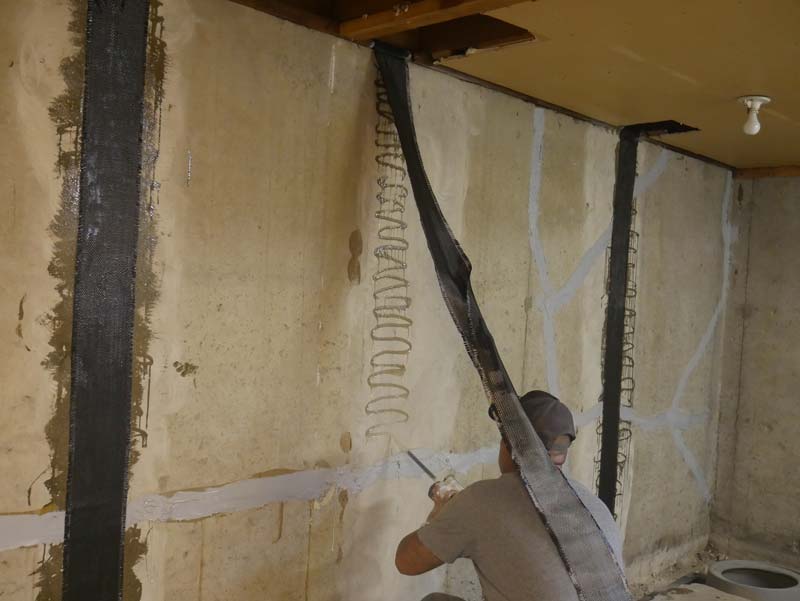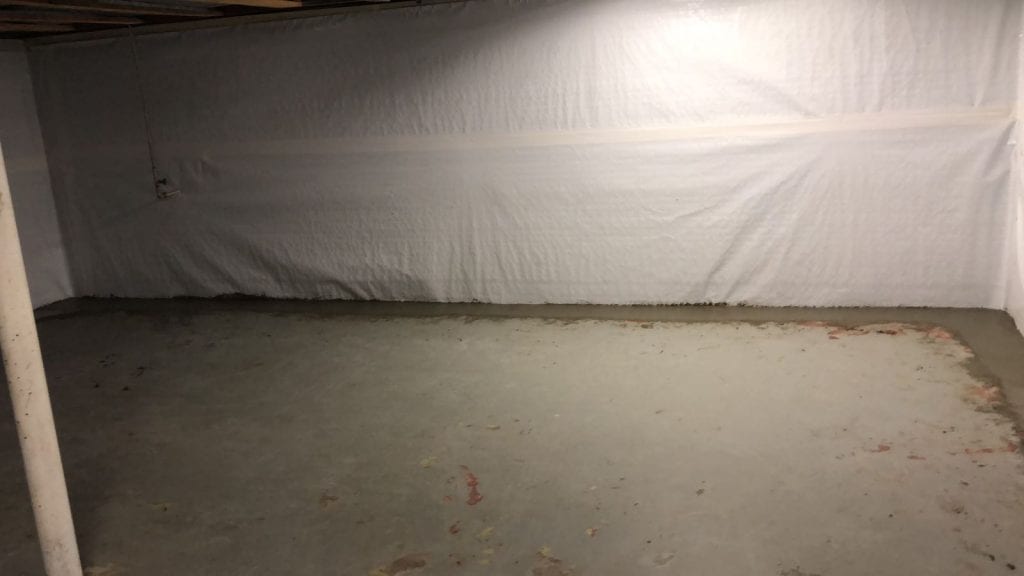
Unable to decide between interior and exterior basement waterproofing for your home? You are not alone. Many homeowners wrestle with the decision between these two waterproofing techniques. While both methods are designed to protect your home from external moisture, each one has different functionality and addresses different issues. To make the right choice for your home, you need to first understand the fundamentals of both of these waterproofing methods. This blog will provide in-depth information about various aspects of interior and exterior basement waterproofing techniques, helping you determine the best solution for a dry and safe basement.
Causes of Basement Water Problems
The following are some of the common causes of moisture issues in basements:
Poor Drainage
Negative landscape grading, clogged or missing gutters and downspouts, and improper interior drainage systems are common contributors to water issues in your basement. When your home lacks a proper drainage system, surface water accumulates near the basement. Standing water can find its way into the basement, increasing the risk of water damage, mold and pest infestations, and damage to the structural components.
Cracks in Foundation Walls
Foundations develop hairline cracks over time due to natural settling of the house. These small cracks are usually harmless. However, the cracks formed due to hydrostatic pressure and excessive settling of the foundation can cause major concerns. When the soil surrounding the foundation becomes saturated, moisture seeps through the cracks, causing dampness, water puddles, and damage to any items stored in your basement.
Hydrostatic Pressure
Hydrostatic pressure is a lateral force exerted by the saturated soil around your foundation. During heavy rainfall or snowfall, the soil absorbs excess water, creating a buildup of pressure. This force pushes the basement walls inward, leading to the formation of cracks that may leak. Over time, this pressure weakens the walls, increasing the risk of structural collapse.
High Water Table
Some areas have naturally high water tables, especially during wet seasons. This may lead to the formation of cracks and groundwater accumulation in your basement.
What is Interior Basement Waterproofing?
Interior basement waterproofing is a system designed to redirect water that has already entered your basement. Instead of blocking water from the outside, this system prioritizes controlling water from inside the basement by collecting it and safely draining it out of your home. This solution helps keep your basement dry even during heavy rainfall and snowfall.
How It Works
This method works by controlling and redirecting water that has already entered the basement. It doesn’t stop water from entering your foundation, but it captures it the moment it enters and channels it away from your property before it causes water damage in your basement. This system often involves creating a path of least resistance for water that enters so that it does not spread to other areas. This effectively streamlines the drainage system, preventing water buildup inside your home.
Common Methods
An effective interior basement waterproofing system involves a combination of different waterproofing methods that are specifically designed to prevent water accumulation. It includes sealing cracks and gaps with industry-grade sealants to prevent water seepage. Drain tile can be installed around the edges of the basement and connected to a sump pump to automatically pump out water away from your foundation. Dehumidifier installation helps keep the air inside your basement dry as well.
When It’s Recommended
Interior waterproofing methods are often recommended for homes that are already experiencing water seeping through the basement walls and floors. It is also an effective choice when external excavation is not possible due to a lack of sufficient space around the property. This is also an ideal choice for homeowners with budget constraints.

What is Exterior Basement Waterproofing?
Exterior basement waterproofing is a preventive solution that stops water before it reaches the basement walls. This approach involves excavating the soil around your home’s perimeter and installing a protective barrier that shields your home by keeping groundwater and moisture from breaching the exterior surfaces of your foundation walls and floor. This helps address the water problem at its source, minimizing the risk of water damage.
How It Works
The process works by creating a protective layer around your foundation. Once the foundation walls are exposed through excavation, a durable, thick waterproof membrane or sealant can be applied to the surface. This acts as a waterproof coating for your basement. A French drain can also be installed around the perimeter of your foundation to divert water away from the basement. This process prevents water from seeping through your foundation.
Common Methods
One of the main techniques involved in exterior waterproofing is applying sealant coatings to create a waterproof layer on the external surface of basement walls. A perforated drain pipe is installed along the perimeter of your foundation to facilitate the easy flow of groundwater or surface water. Some other methods include installing a gutter system, downspout extensions, and window wells, as well as correcting the landscape grading to make sure that water does not accumulate around your foundation.
When It’s Recommended
This waterproofing technique is highly recommended during the construction of a new home. It is also an ideal solution for homes with persistent water intrusion issues. If your home is located in an area with a high wate table, exterior waterproofing can provide long-term protection from water issues in your basement.
Key Differences Between Interior and Exterior Basement Waterproofing
Below are the main differences between interior and exterior basement waterproofing systems:
Installation Method
Interior waterproofing is installed from inside your basement. Exterior waterproofing requires excavation to expose the exterior surface of your foundation walls or install a French drain.
Cost
Interior waterproofing is a more budget-friendly option than exterior waterproofing when comparing waterproofing costs. The labor and materials used in interior waterproofing are less expensive because it does not involve extensive excavation.
Disruption
Installing interior waterproofing systems causes the least disruption to your landscape and your daily routine. Since interior waterproofing takes place in your basement, it does not disrupt your landscaping. On the other hand, exterior waterproofing may damage the landscaping around your foundation. It involves excavation and the use of noisy equipment.
Longevity
Exterior waterproofing systems are usually considered a more permanent solution because the protective barriers are buried beneath the soil. The waterproofing materials are protected from the weather elements and physical damage, making them last longer. On the other hand, an interior waterproofing system requires regular maintenance and replacement to enhance the lifespan of its components, such as sump pumps and rain tile.
Effectiveness
An exterior system is effective for preventing water from entering the basement. This helps retain your foundation’s structural integrity. An interior system is effective for managing and removing water that enters the basement. This method protects the interior of your basement from potential water damage.
How to Choose the Right Waterproofing Method
Here’s how you can select the most efficient waterproofing method for your basement:
Consider the Severity of the Water Problem
Assessing the severity of water damage in your basement can lead you to the right waterproofing solution. For minor cracks and internal drainage issues, interior waterproofing is an ideal choice. If you are dealing with persistent dampness or standing water in your basement, your home will likely require exterior waterproofing solutions or a combination of the two.
Evaluate the Age and Condition of Your Foundation
Newer foundations with minor cracks can be fixed with an interior waterproofing system. But an older foundation with severe dampness and widening cracks may indicate exterior waterproofing issues. In such cases, an exterior system is an ideal solution to minimize further water damage.
Assess Your Budget and Timeline
Determine your budget and timeline and choose accordingly. Interior waterproofing is usually more affordable and can be completed faster with fewer disruptions. On the other hand, exterior waterproofing is more costly and takes longer to complete.
Consult a Waterproofing Professional for Inspection and Advice
Do not hesitate to contact a professional for your basement waterproofing needs. Professionals have the expertise to address water issues effectively. They will provide an accurate diagnosis and recommend the best possible solution that is tailored to meet your basement’s waterproofing needs. If you’re not sure how to waterproof your basement, contact Kansas City basement waterproofing experts, KC Waterproofing, today for a free consultation.
Frequently Asked Questions (FAQs)
Can I combine both methods for better protection?
Yes, you can combine both interior and exterior basement waterproofing techniques for enhanced protection. Exterior waterproofing stops water from entering, whereas interior waterproofing acts as a backup system that manages moisture that enters the basement. This combination is highly recommended if you live in an area with a high water table or experience heavy rainfall or snowfall.
Is interior waterproofing enough to stop mold?
Interior waterproofing is an excellent choice for preventing water intrusion in your basement, but it may not be enough to stop mold formation. Mold grows because of persistent moisture, which includes humidity in the air. While a waterproofing system can help reduce moisture entering your basement, it does not address the dampness that already exists in your basement.
How long do waterproofing systems last?
The lifespan of basement waterproofing is based on the materials used and the quality of installation. Exterior barriers and drainage systems around the foundation may protect your home for 20 to 30 years or more. Interior waterproofing systems have different components, each with a different lifespan. Drain tile can work efficiently for up to 40 years. A sump pump may last for upto 10 years. The overall longevity of any basement waterproofing system also depends on how well and how often you maintain it.
Do I need a sump pump for both basement waterproofing methods?
A sump pump is an important component of an interior basement waterproofing system. Its job is to collect water from the interior drain system and pump it out and away from your house. For exterior waterproofing, a sump pump is not required.
Does waterproofing increase home resale value?
Yes, a professional basement waterproofing solution can contribute to an increase in your home’s resale value. A dry, protected basement is a major selling point because it signals that the home is structurally safe and free from water damage, like wood rot.










